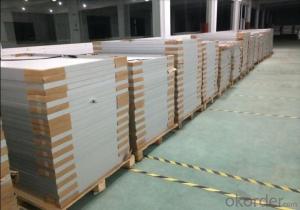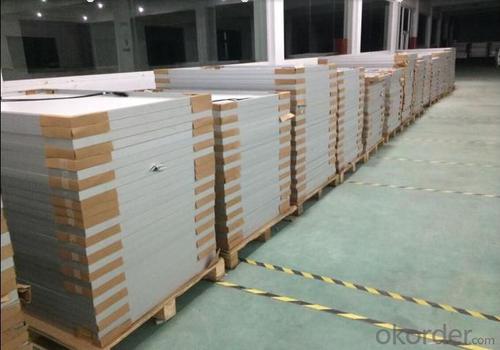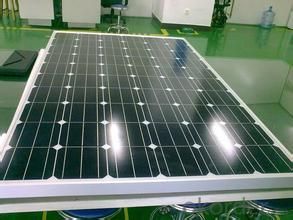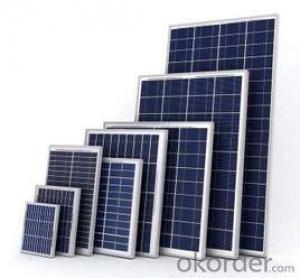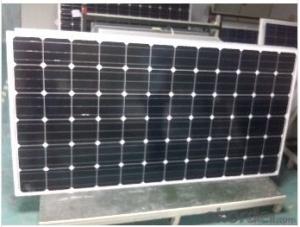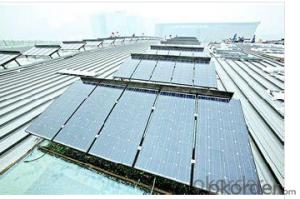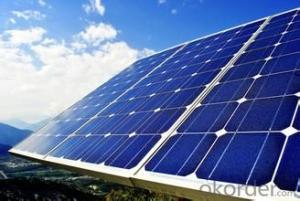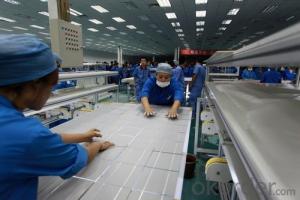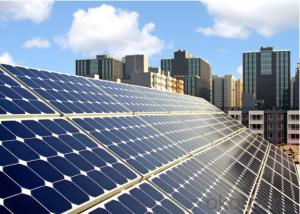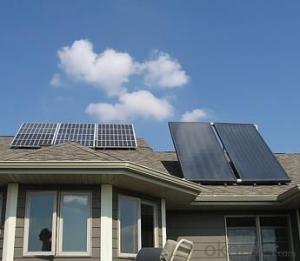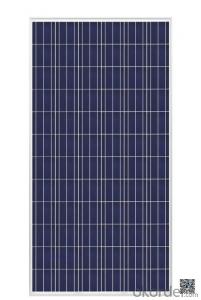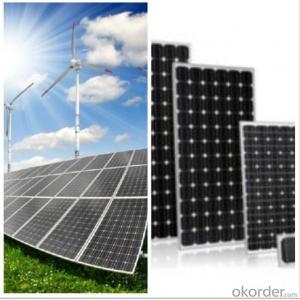Wall Mount Solar Panels - 195w 210w Poly Panel for Solar System with All Certificate
- Loading Port:
- Shanghai
- Payment Terms:
- TT OR LC
- Min Order Qty:
- 406 pc
- Supply Capability:
- 100000 pc/month
OKorder Service Pledge
OKorder Financial Service
You Might Also Like
Specification
195W 210W Poly Panel for Solar System with all Certificate
MANAGEMENT SYSTEM
ISO 9001: Quality management system
ISO 14001: Standard for environmental management system
OHSAS 18001: International standard for occupational health and safety assessment system
Safety
1. salt mist corrosion (IEC61701, tested in Intertek)
2. ammonia corrosion (IEC62716, tested in TÜV SÜD)
3. fire risk (Class C, tested in TÜV SÜD and Rheinland)
Reliability
1. PID free products, passing TÜV SÜD system voltage durability test
2. World 1st company to pass “Thresher Test” and “On-site Power Measurement Validation” certificate
3. Bankable products
Performance
1. Advanced glass and solar cell surface texturing allow for excellent performance in low-light environments
2. 100% In-line Electroluminescence (EL) tested during production process ensures modules are high quality
3. Top rank in Photon yield measurement
Electrical Characteristics
Electrical Characteristics
STC: lrradiance 1000 W/m2 module temperature 25OC AM=1.5;
Power measurement tolerance: +/-3%
SRP-195-5MB SRP-200-5MB SRP-205-5MB SRP-210-5MB Unit
Rated Power at STC (Pmp) W
Power Tolerance W
Maximum Power at STC W
Minimum Module Efficiency (ηm) %
Open Circuit Voltage (Voc) V
Short Circuit Current (Isc) A
Maximum Power Voltage (Vmp) V
Maximum Power Current (Imp) A
Maximum System Voltage 1000 (TÜV), 600 (UL) V
Maximum Series Fuse Rating 10 A
Temperature Characteristics
Pmax Temperature Coefficient -0.43 %/°C
Voc Temperature Coefficient -0.32 %/°C
Isc Temperature Coefficient +0.04 %/°C
Operating Temperature -40~+85 °C
Nominal Operating Cell Temperature (NOCT) 45±2 °C
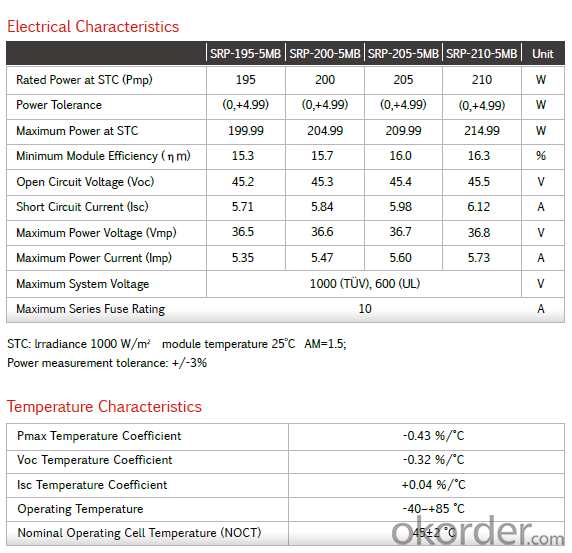
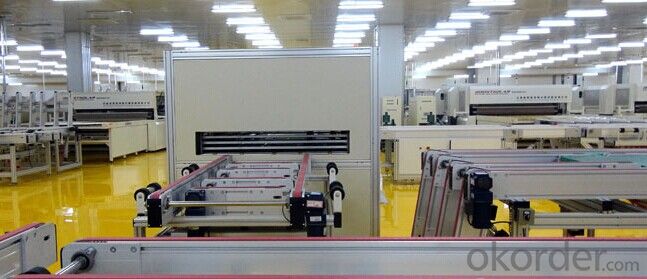
FAQ about Monocrystalline Solar Panel
1. Q: How do I pay for my purchase order?
A: T/T, L/C at sight
2. Q: How can I get sample and how long will it takes?
A: Sample fee will doutbed, but we will return the extra money after you place an order to us, It usually takes 1-3days to produce a sample.
3. Q: What's the MOQ?
A: Depend customer's demand.
4. Q: What's the time delivery?
A: It will take about 5-10 days to finish an order. But the exact time is according to actual situation.
5. Q: Can I have my own customized product?
A: Yes, your customized requirements for color, logo, design, package,shipping marks etc are available.
6. Q: Do you have quality control?
A: Yes, we take great control of the quality.
7. Q:How about the quality?
A: 10-25 Years.
- Q: Can solar panels be used for powering traffic lights?
- Yes, solar panels can be used to power traffic lights. Solar panels convert sunlight into electricity, which can be used to power various devices, including traffic lights. This allows for a sustainable and renewable energy source for traffic signals, reducing reliance on traditional power grids and minimizing environmental impact.
- Q: is a wind turbine better than solar panels
- is your place has enough wind or sunshine ? the turbine is not easily for maintenance. the solar panel is more stable, one broken panel willl not affect the whole system much
- Q: Can solar panels be installed on a factory or industrial facility?
- Yes, solar panels can be installed on a factory or industrial facility. In fact, many factories and industrial facilities are increasingly adopting solar power as a sustainable and cost-effective energy solution. By installing solar panels, these facilities can reduce their reliance on traditional electricity sources, lower their carbon footprint, and potentially save on energy costs in the long run.
- Q: I have tried researching on the internet and just cant find any real answer. I know that the amount of electricity produced when taking in the suns rays depends on the placement of the solar panels but I am just looking for ball park figures. Thanks
- call your power company and ask them how much they pay for each kWh you feed back into the grid (the price may vary for different times of the day). then multiply that by however much electricity you are producing.
- Q: Can solar panels be installed on disaster relief shelters?
- Yes, solar panels can be installed on disaster relief shelters. Solar panels are a versatile and sustainable solution that can provide electricity for lighting, charging electronic devices, and powering essential equipment in disaster-affected areas. They are portable, easy to install, and can help ensure a reliable source of energy in remote or inaccessible locations.
- Q: i need to make a mini-solar car which shouldn't cost much. it's for my science project. for now, i just found out how to make a solar panel using copper oxide, but it does not generate enough power to power up the engine of the toy car [ the small engine they used in the toys, like from TAMIA]
- try adding more solar panels to your car, what if you take the solar panels out of 2 or 3 calulators , add them, then use some tiny mirrors to help draw more light into the panels,.--------------------------------... solar cell (or a photovoltaic cell) is a device that converts photons from the sun (solar light) into electricity. In general, a solar cell that includes the capacity to capture both solar and nonsolar sources of light (such as photons from incandescent bulbs) is termed a photovoltaic cell. Fundamentally, the device needs to fulfill only two functions: photogeneration of charge carriers (electrons and holes) in a light-absorbing material, and separation of the charge carriers to a conductive contact that will transmit the electricity. This conversion is called the photovoltaic effect, and the field of research related to solar cells is known as photovoltaics. Solar cells have many applications. Historically solar cells have been used in situations where electrical power from the grid is unavailable, such as in remote area power systems, Earth orbiting satellites or space probes , consumer systems, e.g. handheld calculators or wrist watches, remote radiotelephones and water pumping applications. Recently solar cells are particularly used in assemblies of solar modules (photovoltaic arrays) connected to the electricity grid through an inverter, often in combination with a net metering arrangement. Solar cells are regarded as one of the key technologies towards a sustainable energy supply.
- Q: Can solar panels be installed in a shaded area?
- Solar panels can still be installed in a shaded area, but their efficiency will be significantly reduced as they rely on direct sunlight to generate electricity.
- Q: I have a question about solar panels. What are the benefits of this system if I installed in my home. for example i know it produces electricity but does it do anything else? How many panel would you guys think I would need for 2000 sq ft. do you know if it produces hot water? Thanks for your help
- Grid-tied solar systems in the U.S. run at least $8/watt installed. To completely run a 2,000 sq ft home, you'd need about 50 amps service from solar -- both 20 volts and 240 volts. Not very practical. Panels are expensive, but the BOS (balance of system) is as well. You need mounts to bolt the panels to the roof (same thing if ground mounted). Cable, wire, and connectors will run several hundred dollars. A couple of grid-tie inverters in the range of 4,000 watts each will cost you several $6,000 to $8,000, plus sub panels, combiner boxes, breakers, disconnects, charge controls, and batteries, among other things. You'd likely need 5 to 24 panels, depending on too many factors to mention here. You'd need at least 8 batteries, likely 2 volt ones, probably more if you want to run the entire home from solar. Solar (or wind) systems have to be installed in the U.S. by state licensed installers, and there are not many of those yet. And if you grid-tie the system, you'll need to put an interconnection agreement in place with your local utility, plus the utility will have requirements on the net-metering and installation of a switch they can use to turn your solar system off from the grid. And this would not produce hot water in the way you are thinking. If you have an electric hot water heater now, the solar system could help run that, just like the rest of your home. Hot water from solar and electricity from solar are two completely different technologies.
- Q: Can solar panels be used for powering wireless charging stations?
- Yes, solar panels can be used to power wireless charging stations. Solar panels convert sunlight into electricity, which can be utilized to charge devices wirelessly through a charging station. This makes it a sustainable and environmentally friendly option for providing power to wireless charging stations.
- Q: Can solar panels be installed on residential homes?
- Yes, solar panels can be installed on residential homes.
Send your message to us
Wall Mount Solar Panels - 195w 210w Poly Panel for Solar System with All Certificate
- Loading Port:
- Shanghai
- Payment Terms:
- TT OR LC
- Min Order Qty:
- 406 pc
- Supply Capability:
- 100000 pc/month
OKorder Service Pledge
OKorder Financial Service
Similar products
Hot products
Hot Searches
Related keywords
